COIT20249 - 3D Printing Technology: Applications, Advantages
VerifiedAdded on 2023/06/12
|12
|3652
|378
Report
AI Summary
This report delves into the applications of 3D printing technology, highlighting its use in creating human tissues and organs through bio-printing, low-cost prototyping and housing, and customized food preparation. It discusses the advantages of 3D printing, such as product customization, rapid prototyping, reduced production costs, and the potential for organ creation. The report also addresses the disadvantages of the technology. It concludes with recommendations for embracing 3D printing in business, considering social and ethical implications. The analysis draws from various academic sources to provide a comprehensive overview of 3D printing's current state and future possibilities.
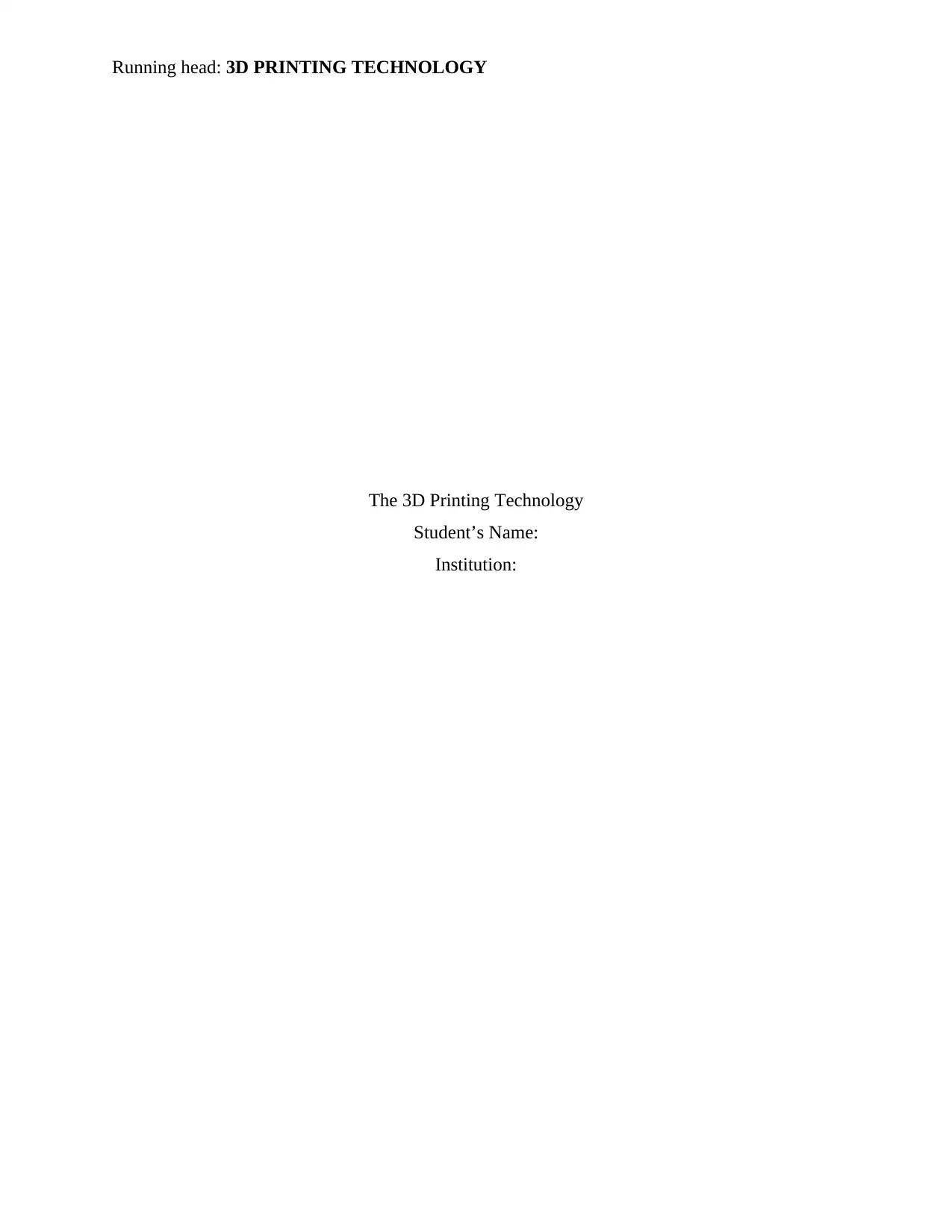
Running head: 3D PRINTING TECHNOLOGY
The 3D Printing Technology
Student’s Name:
Institution:
The 3D Printing Technology
Student’s Name:
Institution:
Paraphrase This Document
Need a fresh take? Get an instant paraphrase of this document with our AI Paraphraser
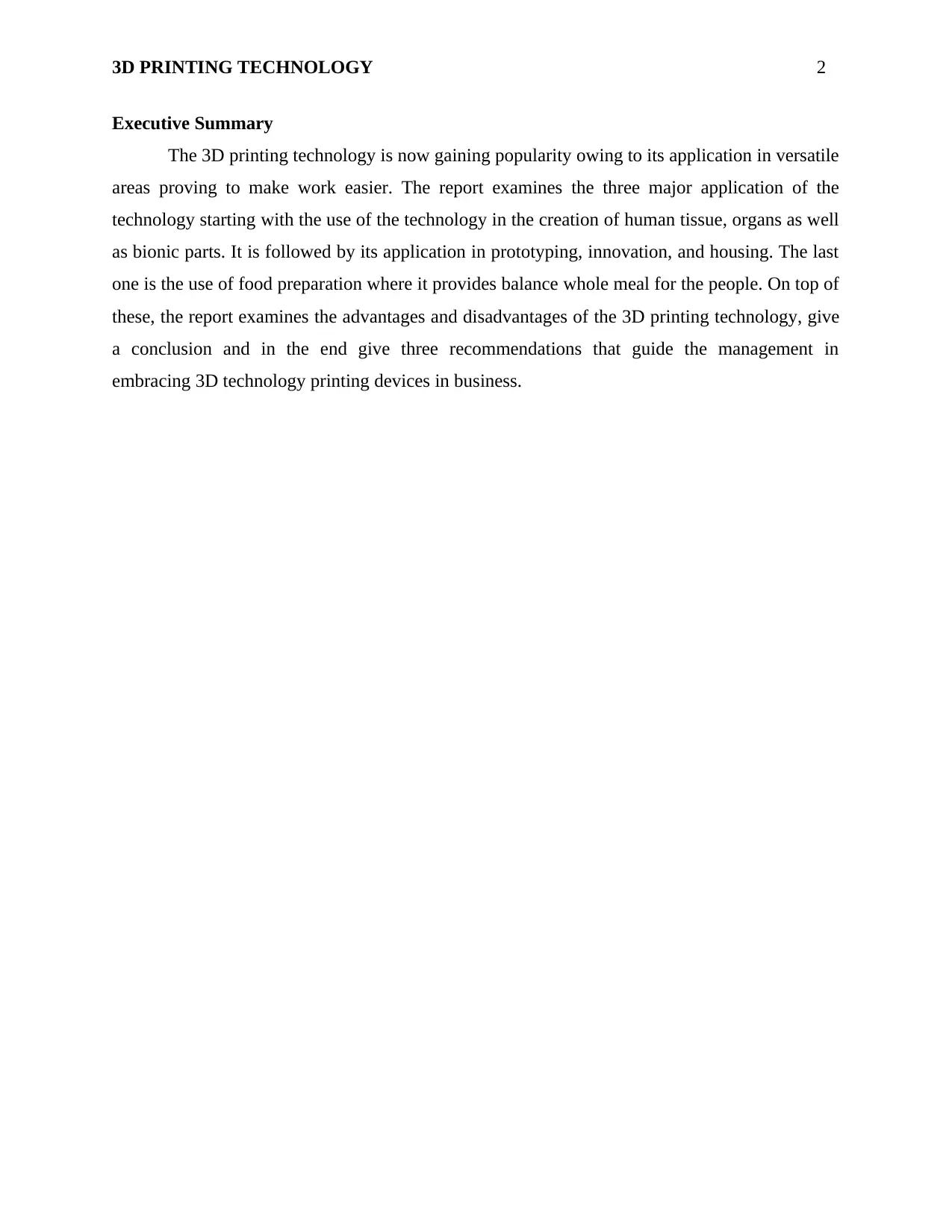
3D PRINTING TECHNOLOGY 2
Executive Summary
The 3D printing technology is now gaining popularity owing to its application in versatile
areas proving to make work easier. The report examines the three major application of the
technology starting with the use of the technology in the creation of human tissue, organs as well
as bionic parts. It is followed by its application in prototyping, innovation, and housing. The last
one is the use of food preparation where it provides balance whole meal for the people. On top of
these, the report examines the advantages and disadvantages of the 3D printing technology, give
a conclusion and in the end give three recommendations that guide the management in
embracing 3D technology printing devices in business.
Executive Summary
The 3D printing technology is now gaining popularity owing to its application in versatile
areas proving to make work easier. The report examines the three major application of the
technology starting with the use of the technology in the creation of human tissue, organs as well
as bionic parts. It is followed by its application in prototyping, innovation, and housing. The last
one is the use of food preparation where it provides balance whole meal for the people. On top of
these, the report examines the advantages and disadvantages of the 3D printing technology, give
a conclusion and in the end give three recommendations that guide the management in
embracing 3D technology printing devices in business.
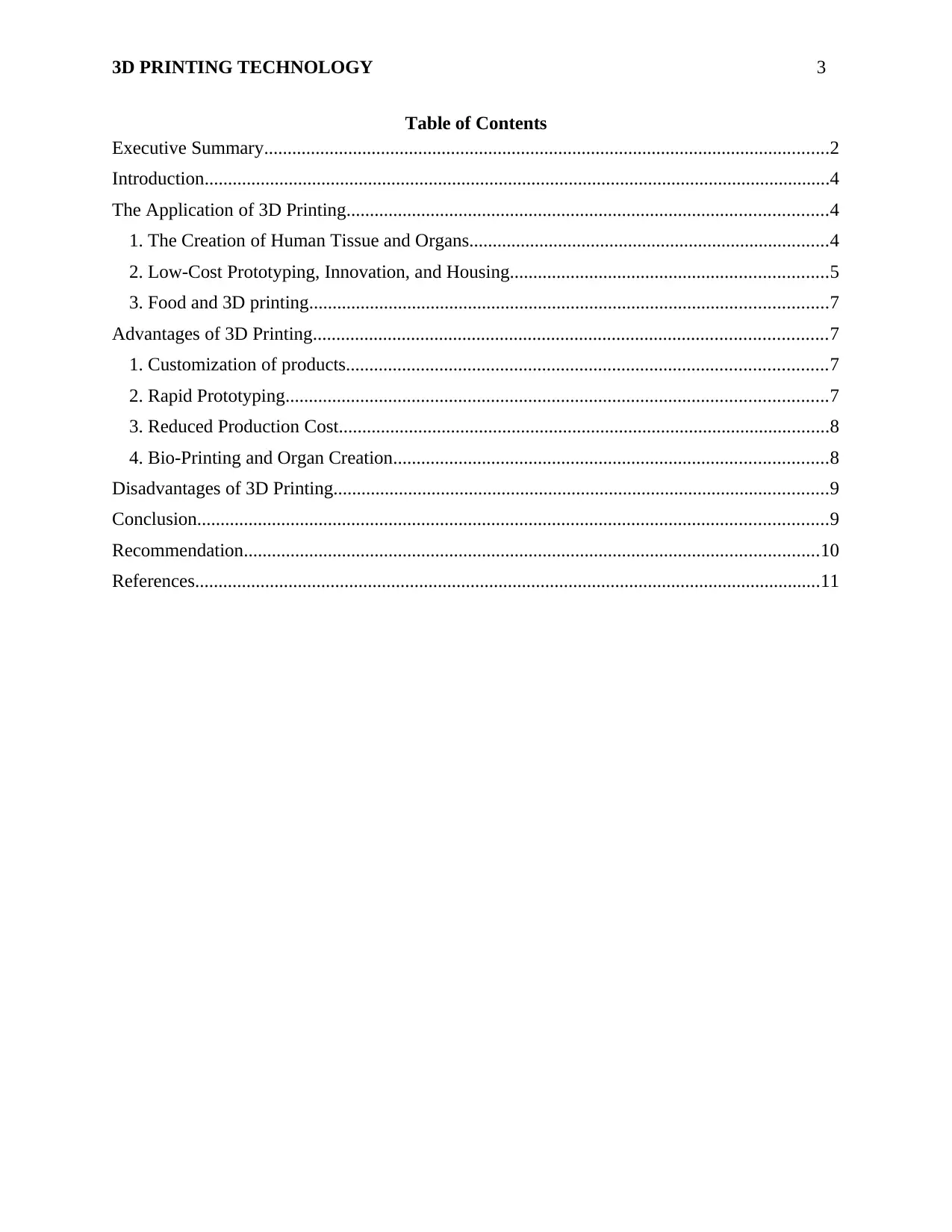
3D PRINTING TECHNOLOGY 3
Table of Contents
Executive Summary.........................................................................................................................2
Introduction......................................................................................................................................4
The Application of 3D Printing.......................................................................................................4
1. The Creation of Human Tissue and Organs.............................................................................4
2. Low-Cost Prototyping, Innovation, and Housing....................................................................5
3. Food and 3D printing...............................................................................................................7
Advantages of 3D Printing..............................................................................................................7
1. Customization of products.......................................................................................................7
2. Rapid Prototyping....................................................................................................................7
3. Reduced Production Cost.........................................................................................................8
4. Bio-Printing and Organ Creation.............................................................................................8
Disadvantages of 3D Printing..........................................................................................................9
Conclusion.......................................................................................................................................9
Recommendation...........................................................................................................................10
References......................................................................................................................................11
Table of Contents
Executive Summary.........................................................................................................................2
Introduction......................................................................................................................................4
The Application of 3D Printing.......................................................................................................4
1. The Creation of Human Tissue and Organs.............................................................................4
2. Low-Cost Prototyping, Innovation, and Housing....................................................................5
3. Food and 3D printing...............................................................................................................7
Advantages of 3D Printing..............................................................................................................7
1. Customization of products.......................................................................................................7
2. Rapid Prototyping....................................................................................................................7
3. Reduced Production Cost.........................................................................................................8
4. Bio-Printing and Organ Creation.............................................................................................8
Disadvantages of 3D Printing..........................................................................................................9
Conclusion.......................................................................................................................................9
Recommendation...........................................................................................................................10
References......................................................................................................................................11
⊘ This is a preview!⊘
Do you want full access?
Subscribe today to unlock all pages.

Trusted by 1+ million students worldwide
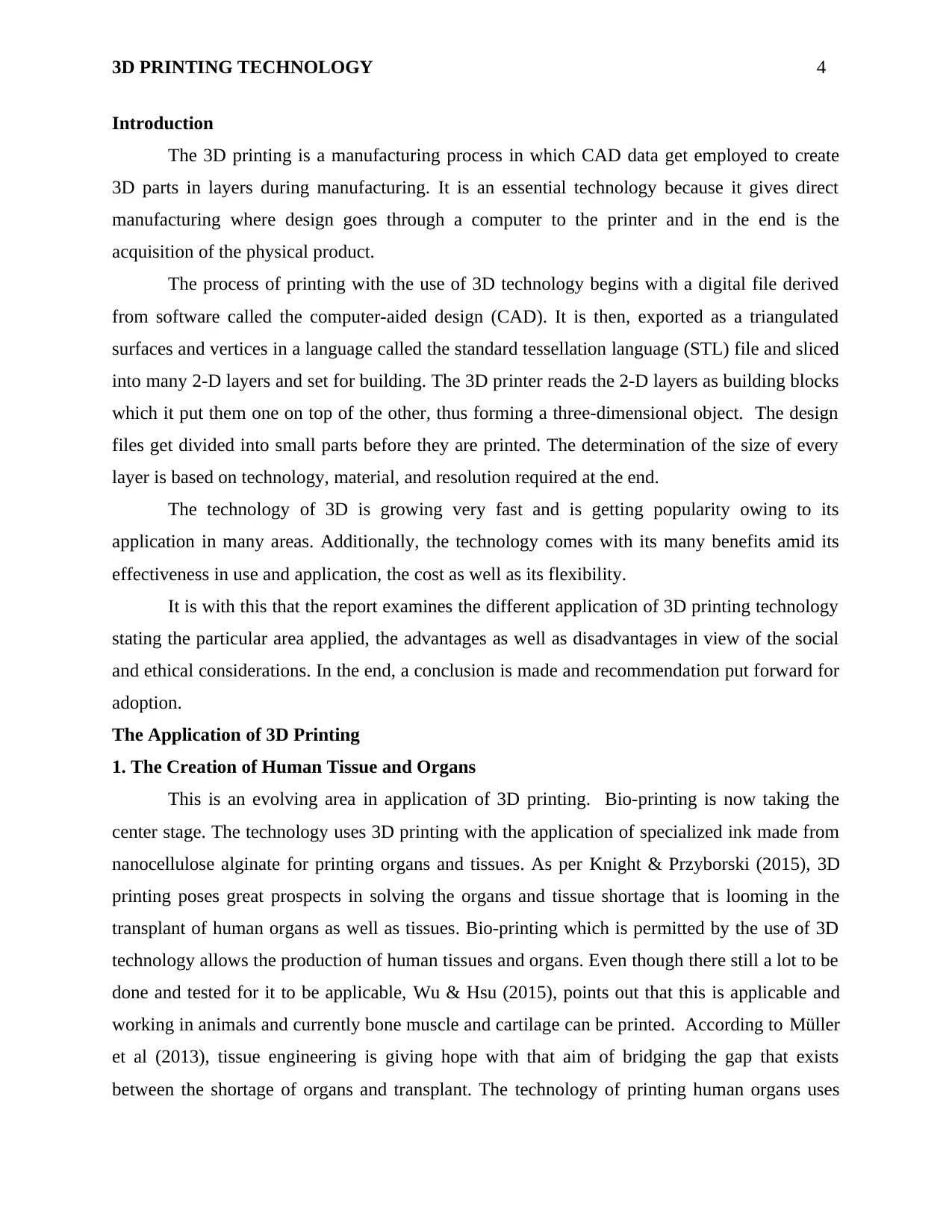
3D PRINTING TECHNOLOGY 4
Introduction
The 3D printing is a manufacturing process in which CAD data get employed to create
3D parts in layers during manufacturing. It is an essential technology because it gives direct
manufacturing where design goes through a computer to the printer and in the end is the
acquisition of the physical product.
The process of printing with the use of 3D technology begins with a digital file derived
from software called the computer-aided design (CAD). It is then, exported as a triangulated
surfaces and vertices in a language called the standard tessellation language (STL) file and sliced
into many 2-D layers and set for building. The 3D printer reads the 2-D layers as building blocks
which it put them one on top of the other, thus forming a three-dimensional object. The design
files get divided into small parts before they are printed. The determination of the size of every
layer is based on technology, material, and resolution required at the end.
The technology of 3D is growing very fast and is getting popularity owing to its
application in many areas. Additionally, the technology comes with its many benefits amid its
effectiveness in use and application, the cost as well as its flexibility.
It is with this that the report examines the different application of 3D printing technology
stating the particular area applied, the advantages as well as disadvantages in view of the social
and ethical considerations. In the end, a conclusion is made and recommendation put forward for
adoption.
The Application of 3D Printing
1. The Creation of Human Tissue and Organs
This is an evolving area in application of 3D printing. Bio-printing is now taking the
center stage. The technology uses 3D printing with the application of specialized ink made from
nanocellulose alginate for printing organs and tissues. As per Knight & Przyborski (2015), 3D
printing poses great prospects in solving the organs and tissue shortage that is looming in the
transplant of human organs as well as tissues. Bio-printing which is permitted by the use of 3D
technology allows the production of human tissues and organs. Even though there still a lot to be
done and tested for it to be applicable, Wu & Hsu (2015), points out that this is applicable and
working in animals and currently bone muscle and cartilage can be printed. According to Müller
et al (2013), tissue engineering is giving hope with that aim of bridging the gap that exists
between the shortage of organs and transplant. The technology of printing human organs uses
Introduction
The 3D printing is a manufacturing process in which CAD data get employed to create
3D parts in layers during manufacturing. It is an essential technology because it gives direct
manufacturing where design goes through a computer to the printer and in the end is the
acquisition of the physical product.
The process of printing with the use of 3D technology begins with a digital file derived
from software called the computer-aided design (CAD). It is then, exported as a triangulated
surfaces and vertices in a language called the standard tessellation language (STL) file and sliced
into many 2-D layers and set for building. The 3D printer reads the 2-D layers as building blocks
which it put them one on top of the other, thus forming a three-dimensional object. The design
files get divided into small parts before they are printed. The determination of the size of every
layer is based on technology, material, and resolution required at the end.
The technology of 3D is growing very fast and is getting popularity owing to its
application in many areas. Additionally, the technology comes with its many benefits amid its
effectiveness in use and application, the cost as well as its flexibility.
It is with this that the report examines the different application of 3D printing technology
stating the particular area applied, the advantages as well as disadvantages in view of the social
and ethical considerations. In the end, a conclusion is made and recommendation put forward for
adoption.
The Application of 3D Printing
1. The Creation of Human Tissue and Organs
This is an evolving area in application of 3D printing. Bio-printing is now taking the
center stage. The technology uses 3D printing with the application of specialized ink made from
nanocellulose alginate for printing organs and tissues. As per Knight & Przyborski (2015), 3D
printing poses great prospects in solving the organs and tissue shortage that is looming in the
transplant of human organs as well as tissues. Bio-printing which is permitted by the use of 3D
technology allows the production of human tissues and organs. Even though there still a lot to be
done and tested for it to be applicable, Wu & Hsu (2015), points out that this is applicable and
working in animals and currently bone muscle and cartilage can be printed. According to Müller
et al (2013), tissue engineering is giving hope with that aim of bridging the gap that exists
between the shortage of organs and transplant. The technology of printing human organs uses
Paraphrase This Document
Need a fresh take? Get an instant paraphrase of this document with our AI Paraphraser
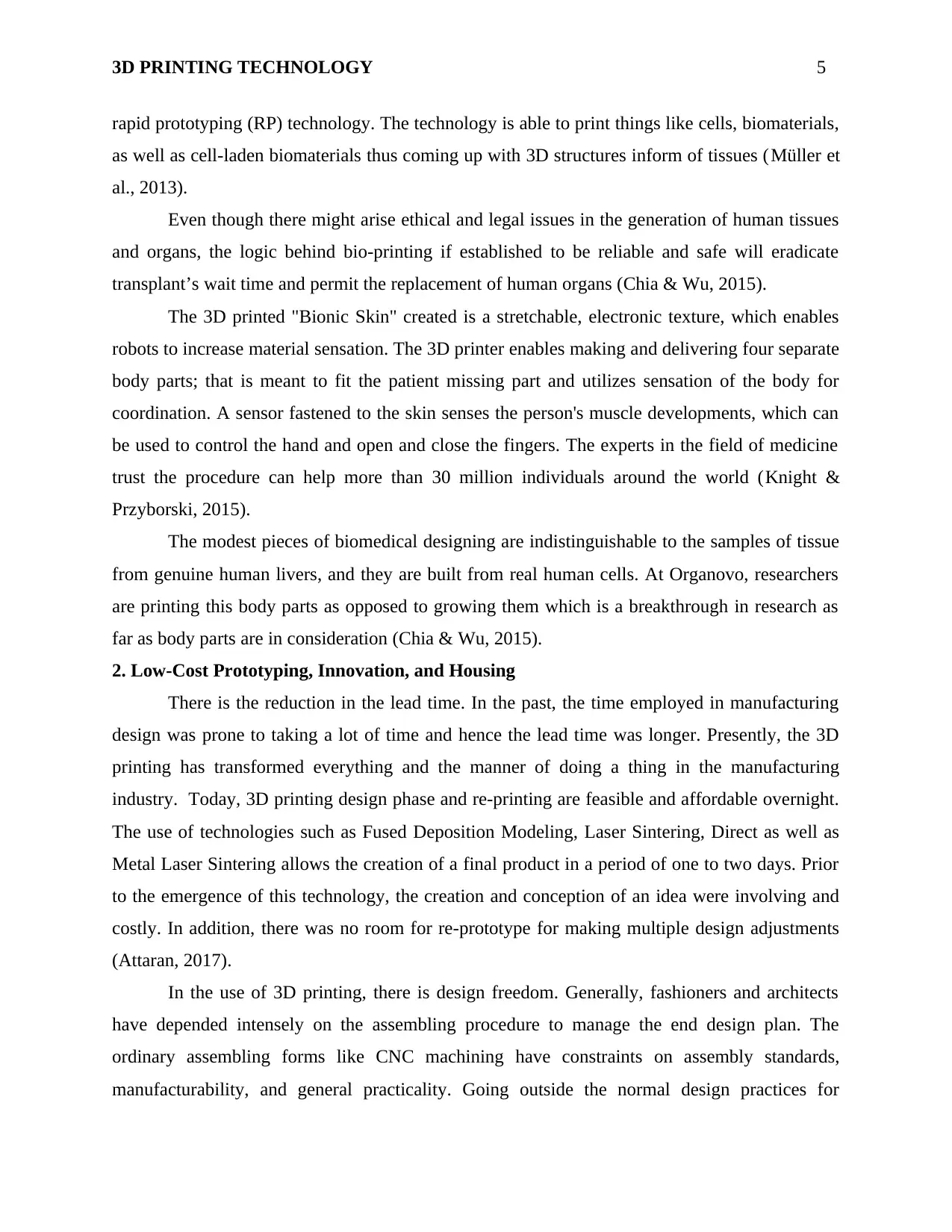
3D PRINTING TECHNOLOGY 5
rapid prototyping (RP) technology. The technology is able to print things like cells, biomaterials,
as well as cell-laden biomaterials thus coming up with 3D structures inform of tissues (Müller et
al., 2013).
Even though there might arise ethical and legal issues in the generation of human tissues
and organs, the logic behind bio-printing if established to be reliable and safe will eradicate
transplant’s wait time and permit the replacement of human organs (Chia & Wu, 2015).
The 3D printed "Bionic Skin" created is a stretchable, electronic texture, which enables
robots to increase material sensation. The 3D printer enables making and delivering four separate
body parts; that is meant to fit the patient missing part and utilizes sensation of the body for
coordination. A sensor fastened to the skin senses the person's muscle developments, which can
be used to control the hand and open and close the fingers. The experts in the field of medicine
trust the procedure can help more than 30 million individuals around the world (Knight &
Przyborski, 2015).
The modest pieces of biomedical designing are indistinguishable to the samples of tissue
from genuine human livers, and they are built from real human cells. At Organovo, researchers
are printing this body parts as opposed to growing them which is a breakthrough in research as
far as body parts are in consideration (Chia & Wu, 2015).
2. Low-Cost Prototyping, Innovation, and Housing
There is the reduction in the lead time. In the past, the time employed in manufacturing
design was prone to taking a lot of time and hence the lead time was longer. Presently, the 3D
printing has transformed everything and the manner of doing a thing in the manufacturing
industry. Today, 3D printing design phase and re-printing are feasible and affordable overnight.
The use of technologies such as Fused Deposition Modeling, Laser Sintering, Direct as well as
Metal Laser Sintering allows the creation of a final product in a period of one to two days. Prior
to the emergence of this technology, the creation and conception of an idea were involving and
costly. In addition, there was no room for re-prototype for making multiple design adjustments
(Attaran, 2017).
In the use of 3D printing, there is design freedom. Generally, fashioners and architects
have depended intensely on the assembling procedure to manage the end design plan. The
ordinary assembling forms like CNC machining have constraints on assembly standards,
manufacturability, and general practicality. Going outside the normal design practices for
rapid prototyping (RP) technology. The technology is able to print things like cells, biomaterials,
as well as cell-laden biomaterials thus coming up with 3D structures inform of tissues (Müller et
al., 2013).
Even though there might arise ethical and legal issues in the generation of human tissues
and organs, the logic behind bio-printing if established to be reliable and safe will eradicate
transplant’s wait time and permit the replacement of human organs (Chia & Wu, 2015).
The 3D printed "Bionic Skin" created is a stretchable, electronic texture, which enables
robots to increase material sensation. The 3D printer enables making and delivering four separate
body parts; that is meant to fit the patient missing part and utilizes sensation of the body for
coordination. A sensor fastened to the skin senses the person's muscle developments, which can
be used to control the hand and open and close the fingers. The experts in the field of medicine
trust the procedure can help more than 30 million individuals around the world (Knight &
Przyborski, 2015).
The modest pieces of biomedical designing are indistinguishable to the samples of tissue
from genuine human livers, and they are built from real human cells. At Organovo, researchers
are printing this body parts as opposed to growing them which is a breakthrough in research as
far as body parts are in consideration (Chia & Wu, 2015).
2. Low-Cost Prototyping, Innovation, and Housing
There is the reduction in the lead time. In the past, the time employed in manufacturing
design was prone to taking a lot of time and hence the lead time was longer. Presently, the 3D
printing has transformed everything and the manner of doing a thing in the manufacturing
industry. Today, 3D printing design phase and re-printing are feasible and affordable overnight.
The use of technologies such as Fused Deposition Modeling, Laser Sintering, Direct as well as
Metal Laser Sintering allows the creation of a final product in a period of one to two days. Prior
to the emergence of this technology, the creation and conception of an idea were involving and
costly. In addition, there was no room for re-prototype for making multiple design adjustments
(Attaran, 2017).
In the use of 3D printing, there is design freedom. Generally, fashioners and architects
have depended intensely on the assembling procedure to manage the end design plan. The
ordinary assembling forms like CNC machining have constraints on assembly standards,
manufacturability, and general practicality. Going outside the normal design practices for
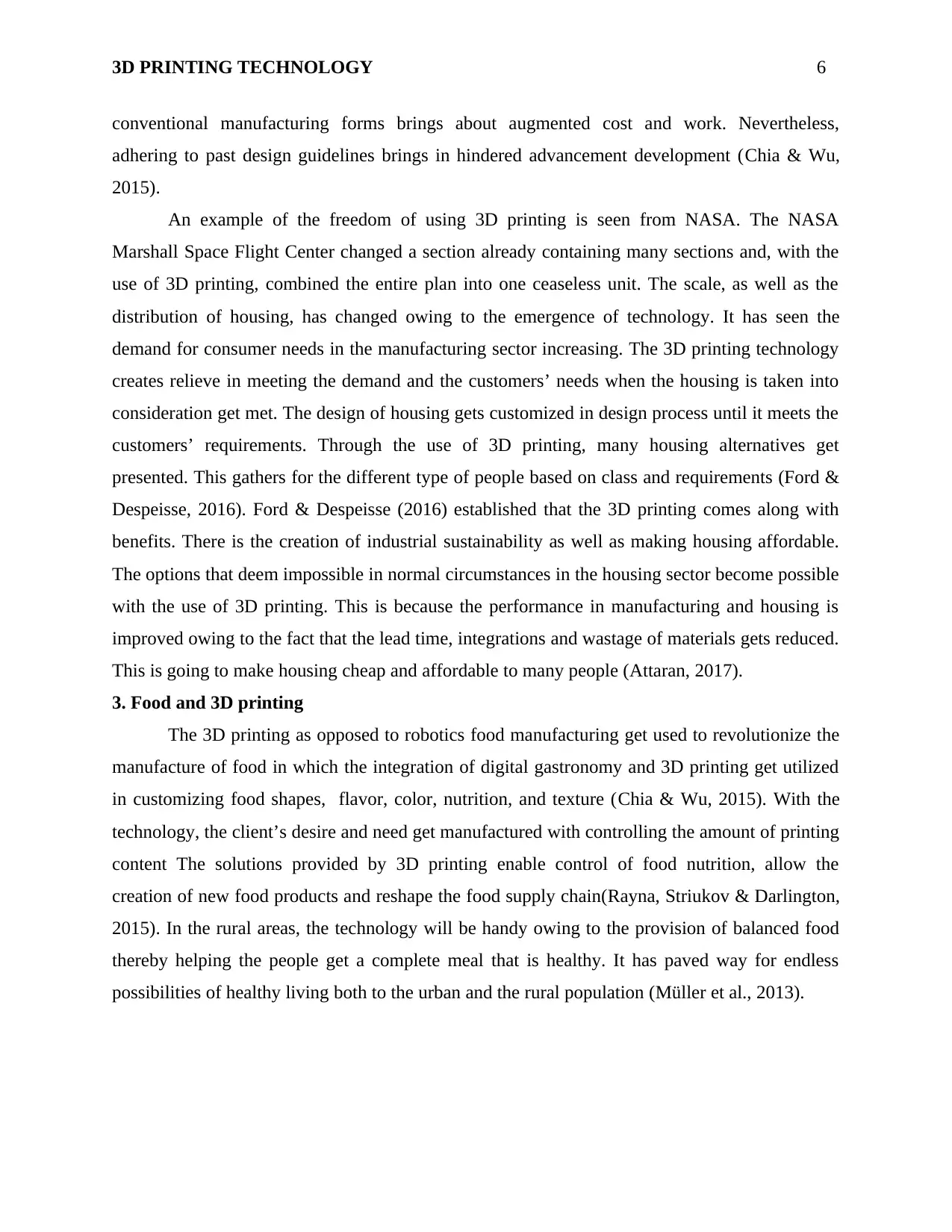
3D PRINTING TECHNOLOGY 6
conventional manufacturing forms brings about augmented cost and work. Nevertheless,
adhering to past design guidelines brings in hindered advancement development (Chia & Wu,
2015).
An example of the freedom of using 3D printing is seen from NASA. The NASA
Marshall Space Flight Center changed a section already containing many sections and, with the
use of 3D printing, combined the entire plan into one ceaseless unit. The scale, as well as the
distribution of housing, has changed owing to the emergence of technology. It has seen the
demand for consumer needs in the manufacturing sector increasing. The 3D printing technology
creates relieve in meeting the demand and the customers’ needs when the housing is taken into
consideration get met. The design of housing gets customized in design process until it meets the
customers’ requirements. Through the use of 3D printing, many housing alternatives get
presented. This gathers for the different type of people based on class and requirements (Ford &
Despeisse, 2016). Ford & Despeisse (2016) established that the 3D printing comes along with
benefits. There is the creation of industrial sustainability as well as making housing affordable.
The options that deem impossible in normal circumstances in the housing sector become possible
with the use of 3D printing. This is because the performance in manufacturing and housing is
improved owing to the fact that the lead time, integrations and wastage of materials gets reduced.
This is going to make housing cheap and affordable to many people (Attaran, 2017).
3. Food and 3D printing
The 3D printing as opposed to robotics food manufacturing get used to revolutionize the
manufacture of food in which the integration of digital gastronomy and 3D printing get utilized
in customizing food shapes, flavor, color, nutrition, and texture (Chia & Wu, 2015). With the
technology, the client’s desire and need get manufactured with controlling the amount of printing
content The solutions provided by 3D printing enable control of food nutrition, allow the
creation of new food products and reshape the food supply chain(Rayna, Striukov & Darlington,
2015). In the rural areas, the technology will be handy owing to the provision of balanced food
thereby helping the people get a complete meal that is healthy. It has paved way for endless
possibilities of healthy living both to the urban and the rural population (Müller et al., 2013).
conventional manufacturing forms brings about augmented cost and work. Nevertheless,
adhering to past design guidelines brings in hindered advancement development (Chia & Wu,
2015).
An example of the freedom of using 3D printing is seen from NASA. The NASA
Marshall Space Flight Center changed a section already containing many sections and, with the
use of 3D printing, combined the entire plan into one ceaseless unit. The scale, as well as the
distribution of housing, has changed owing to the emergence of technology. It has seen the
demand for consumer needs in the manufacturing sector increasing. The 3D printing technology
creates relieve in meeting the demand and the customers’ needs when the housing is taken into
consideration get met. The design of housing gets customized in design process until it meets the
customers’ requirements. Through the use of 3D printing, many housing alternatives get
presented. This gathers for the different type of people based on class and requirements (Ford &
Despeisse, 2016). Ford & Despeisse (2016) established that the 3D printing comes along with
benefits. There is the creation of industrial sustainability as well as making housing affordable.
The options that deem impossible in normal circumstances in the housing sector become possible
with the use of 3D printing. This is because the performance in manufacturing and housing is
improved owing to the fact that the lead time, integrations and wastage of materials gets reduced.
This is going to make housing cheap and affordable to many people (Attaran, 2017).
3. Food and 3D printing
The 3D printing as opposed to robotics food manufacturing get used to revolutionize the
manufacture of food in which the integration of digital gastronomy and 3D printing get utilized
in customizing food shapes, flavor, color, nutrition, and texture (Chia & Wu, 2015). With the
technology, the client’s desire and need get manufactured with controlling the amount of printing
content The solutions provided by 3D printing enable control of food nutrition, allow the
creation of new food products and reshape the food supply chain(Rayna, Striukov & Darlington,
2015). In the rural areas, the technology will be handy owing to the provision of balanced food
thereby helping the people get a complete meal that is healthy. It has paved way for endless
possibilities of healthy living both to the urban and the rural population (Müller et al., 2013).
⊘ This is a preview!⊘
Do you want full access?
Subscribe today to unlock all pages.

Trusted by 1+ million students worldwide
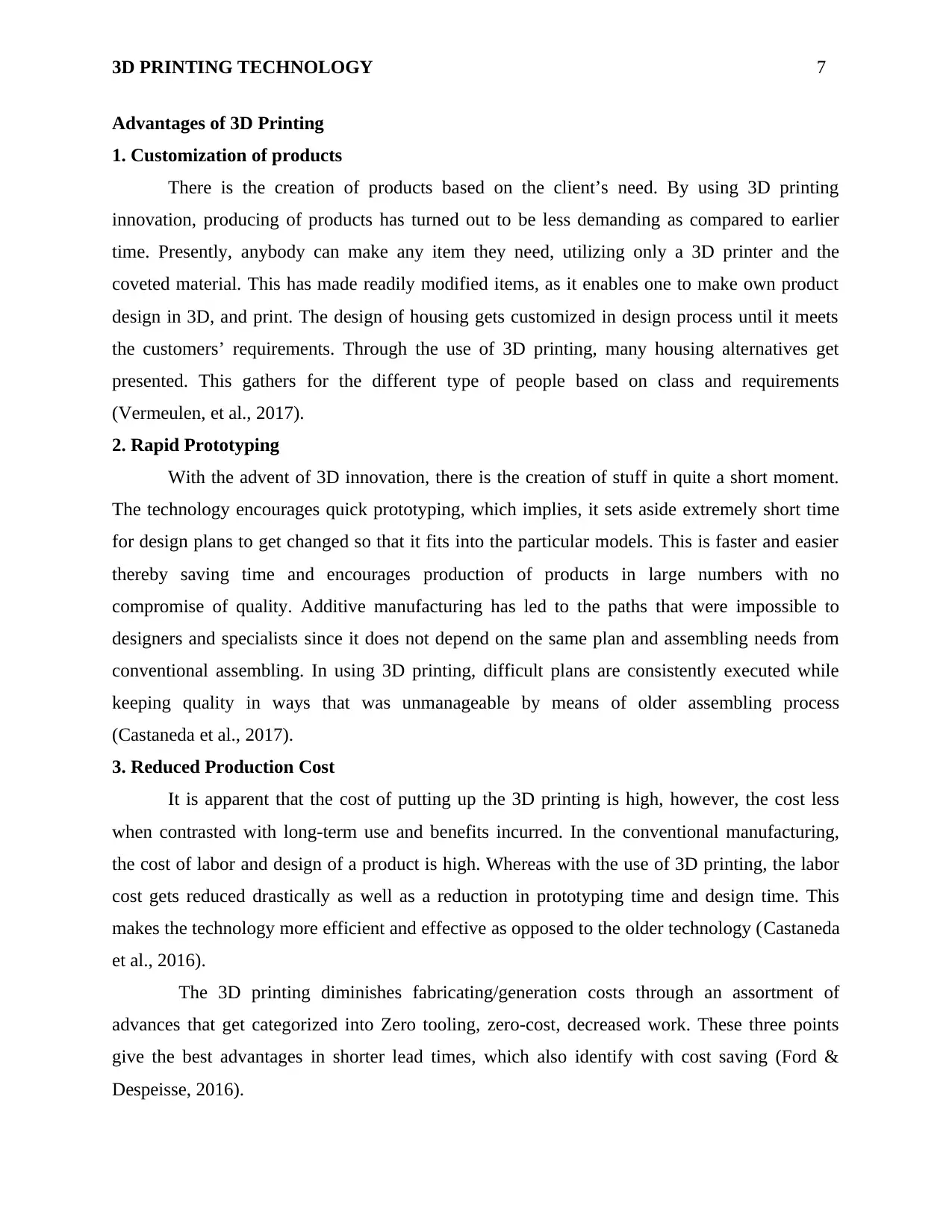
3D PRINTING TECHNOLOGY 7
Advantages of 3D Printing
1. Customization of products
There is the creation of products based on the client’s need. By using 3D printing
innovation, producing of products has turned out to be less demanding as compared to earlier
time. Presently, anybody can make any item they need, utilizing only a 3D printer and the
coveted material. This has made readily modified items, as it enables one to make own product
design in 3D, and print. The design of housing gets customized in design process until it meets
the customers’ requirements. Through the use of 3D printing, many housing alternatives get
presented. This gathers for the different type of people based on class and requirements
(Vermeulen, et al., 2017).
2. Rapid Prototyping
With the advent of 3D innovation, there is the creation of stuff in quite a short moment.
The technology encourages quick prototyping, which implies, it sets aside extremely short time
for design plans to get changed so that it fits into the particular models. This is faster and easier
thereby saving time and encourages production of products in large numbers with no
compromise of quality. Additive manufacturing has led to the paths that were impossible to
designers and specialists since it does not depend on the same plan and assembling needs from
conventional assembling. In using 3D printing, difficult plans are consistently executed while
keeping quality in ways that was unmanageable by means of older assembling process
(Castaneda et al., 2017).
3. Reduced Production Cost
It is apparent that the cost of putting up the 3D printing is high, however, the cost less
when contrasted with long-term use and benefits incurred. In the conventional manufacturing,
the cost of labor and design of a product is high. Whereas with the use of 3D printing, the labor
cost gets reduced drastically as well as a reduction in prototyping time and design time. This
makes the technology more efficient and effective as opposed to the older technology (Castaneda
et al., 2016).
The 3D printing diminishes fabricating/generation costs through an assortment of
advances that get categorized into Zero tooling, zero-cost, decreased work. These three points
give the best advantages in shorter lead times, which also identify with cost saving (Ford &
Despeisse, 2016).
Advantages of 3D Printing
1. Customization of products
There is the creation of products based on the client’s need. By using 3D printing
innovation, producing of products has turned out to be less demanding as compared to earlier
time. Presently, anybody can make any item they need, utilizing only a 3D printer and the
coveted material. This has made readily modified items, as it enables one to make own product
design in 3D, and print. The design of housing gets customized in design process until it meets
the customers’ requirements. Through the use of 3D printing, many housing alternatives get
presented. This gathers for the different type of people based on class and requirements
(Vermeulen, et al., 2017).
2. Rapid Prototyping
With the advent of 3D innovation, there is the creation of stuff in quite a short moment.
The technology encourages quick prototyping, which implies, it sets aside extremely short time
for design plans to get changed so that it fits into the particular models. This is faster and easier
thereby saving time and encourages production of products in large numbers with no
compromise of quality. Additive manufacturing has led to the paths that were impossible to
designers and specialists since it does not depend on the same plan and assembling needs from
conventional assembling. In using 3D printing, difficult plans are consistently executed while
keeping quality in ways that was unmanageable by means of older assembling process
(Castaneda et al., 2017).
3. Reduced Production Cost
It is apparent that the cost of putting up the 3D printing is high, however, the cost less
when contrasted with long-term use and benefits incurred. In the conventional manufacturing,
the cost of labor and design of a product is high. Whereas with the use of 3D printing, the labor
cost gets reduced drastically as well as a reduction in prototyping time and design time. This
makes the technology more efficient and effective as opposed to the older technology (Castaneda
et al., 2016).
The 3D printing diminishes fabricating/generation costs through an assortment of
advances that get categorized into Zero tooling, zero-cost, decreased work. These three points
give the best advantages in shorter lead times, which also identify with cost saving (Ford &
Despeisse, 2016).
Paraphrase This Document
Need a fresh take? Get an instant paraphrase of this document with our AI Paraphraser
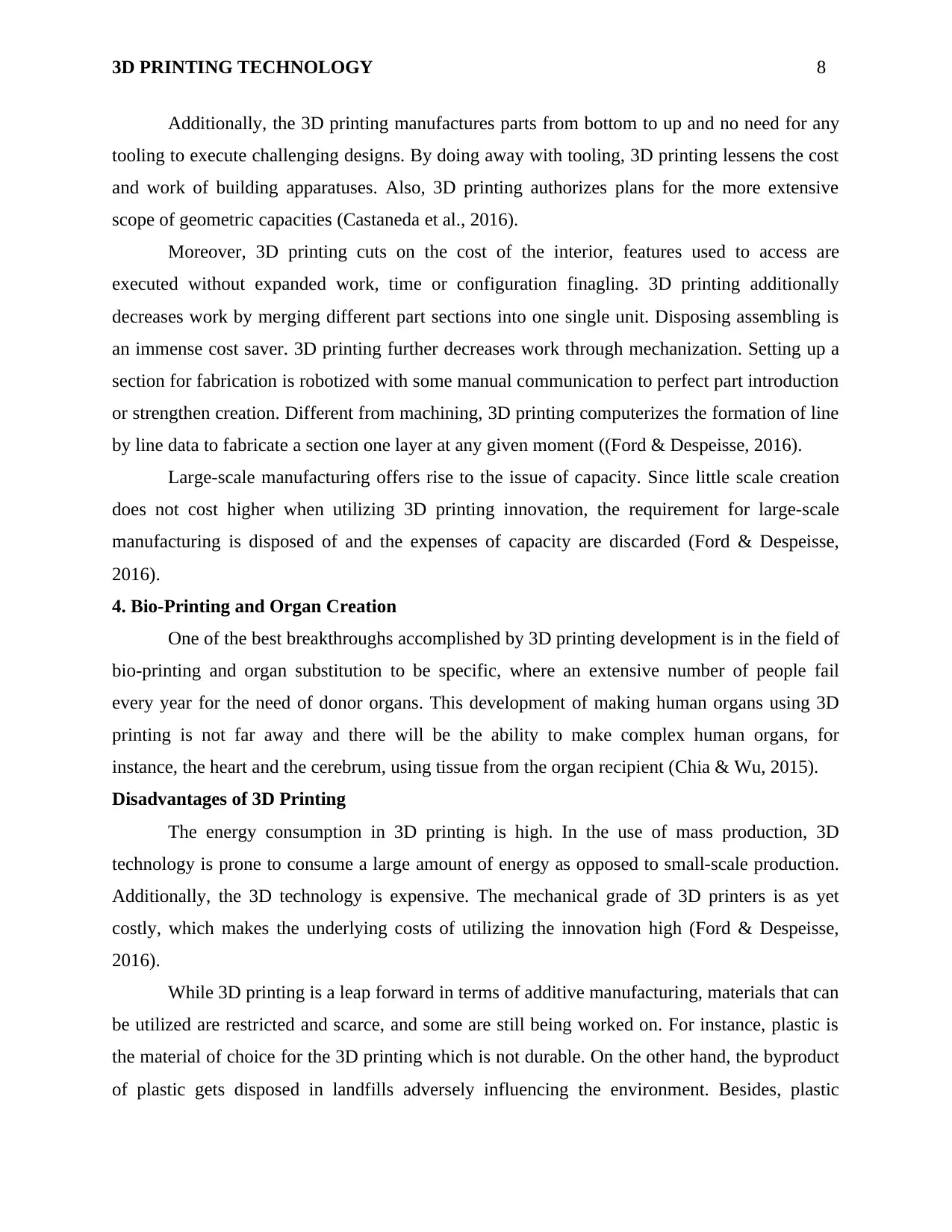
3D PRINTING TECHNOLOGY 8
Additionally, the 3D printing manufactures parts from bottom to up and no need for any
tooling to execute challenging designs. By doing away with tooling, 3D printing lessens the cost
and work of building apparatuses. Also, 3D printing authorizes plans for the more extensive
scope of geometric capacities (Castaneda et al., 2016).
Moreover, 3D printing cuts on the cost of the interior, features used to access are
executed without expanded work, time or configuration finagling. 3D printing additionally
decreases work by merging different part sections into one single unit. Disposing assembling is
an immense cost saver. 3D printing further decreases work through mechanization. Setting up a
section for fabrication is robotized with some manual communication to perfect part introduction
or strengthen creation. Different from machining, 3D printing computerizes the formation of line
by line data to fabricate a section one layer at any given moment ((Ford & Despeisse, 2016).
Large-scale manufacturing offers rise to the issue of capacity. Since little scale creation
does not cost higher when utilizing 3D printing innovation, the requirement for large-scale
manufacturing is disposed of and the expenses of capacity are discarded (Ford & Despeisse,
2016).
4. Bio-Printing and Organ Creation
One of the best breakthroughs accomplished by 3D printing development is in the field of
bio-printing and organ substitution to be specific, where an extensive number of people fail
every year for the need of donor organs. This development of making human organs using 3D
printing is not far away and there will be the ability to make complex human organs, for
instance, the heart and the cerebrum, using tissue from the organ recipient (Chia & Wu, 2015).
Disadvantages of 3D Printing
The energy consumption in 3D printing is high. In the use of mass production, 3D
technology is prone to consume a large amount of energy as opposed to small-scale production.
Additionally, the 3D technology is expensive. The mechanical grade of 3D printers is as yet
costly, which makes the underlying costs of utilizing the innovation high (Ford & Despeisse,
2016).
While 3D printing is a leap forward in terms of additive manufacturing, materials that can
be utilized are restricted and scarce, and some are still being worked on. For instance, plastic is
the material of choice for the 3D printing which is not durable. On the other hand, the byproduct
of plastic gets disposed in landfills adversely influencing the environment. Besides, plastic
Additionally, the 3D printing manufactures parts from bottom to up and no need for any
tooling to execute challenging designs. By doing away with tooling, 3D printing lessens the cost
and work of building apparatuses. Also, 3D printing authorizes plans for the more extensive
scope of geometric capacities (Castaneda et al., 2016).
Moreover, 3D printing cuts on the cost of the interior, features used to access are
executed without expanded work, time or configuration finagling. 3D printing additionally
decreases work by merging different part sections into one single unit. Disposing assembling is
an immense cost saver. 3D printing further decreases work through mechanization. Setting up a
section for fabrication is robotized with some manual communication to perfect part introduction
or strengthen creation. Different from machining, 3D printing computerizes the formation of line
by line data to fabricate a section one layer at any given moment ((Ford & Despeisse, 2016).
Large-scale manufacturing offers rise to the issue of capacity. Since little scale creation
does not cost higher when utilizing 3D printing innovation, the requirement for large-scale
manufacturing is disposed of and the expenses of capacity are discarded (Ford & Despeisse,
2016).
4. Bio-Printing and Organ Creation
One of the best breakthroughs accomplished by 3D printing development is in the field of
bio-printing and organ substitution to be specific, where an extensive number of people fail
every year for the need of donor organs. This development of making human organs using 3D
printing is not far away and there will be the ability to make complex human organs, for
instance, the heart and the cerebrum, using tissue from the organ recipient (Chia & Wu, 2015).
Disadvantages of 3D Printing
The energy consumption in 3D printing is high. In the use of mass production, 3D
technology is prone to consume a large amount of energy as opposed to small-scale production.
Additionally, the 3D technology is expensive. The mechanical grade of 3D printers is as yet
costly, which makes the underlying costs of utilizing the innovation high (Ford & Despeisse,
2016).
While 3D printing is a leap forward in terms of additive manufacturing, materials that can
be utilized are restricted and scarce, and some are still being worked on. For instance, plastic is
the material of choice for the 3D printing which is not durable. On the other hand, the byproduct
of plastic gets disposed in landfills adversely influencing the environment. Besides, plastic
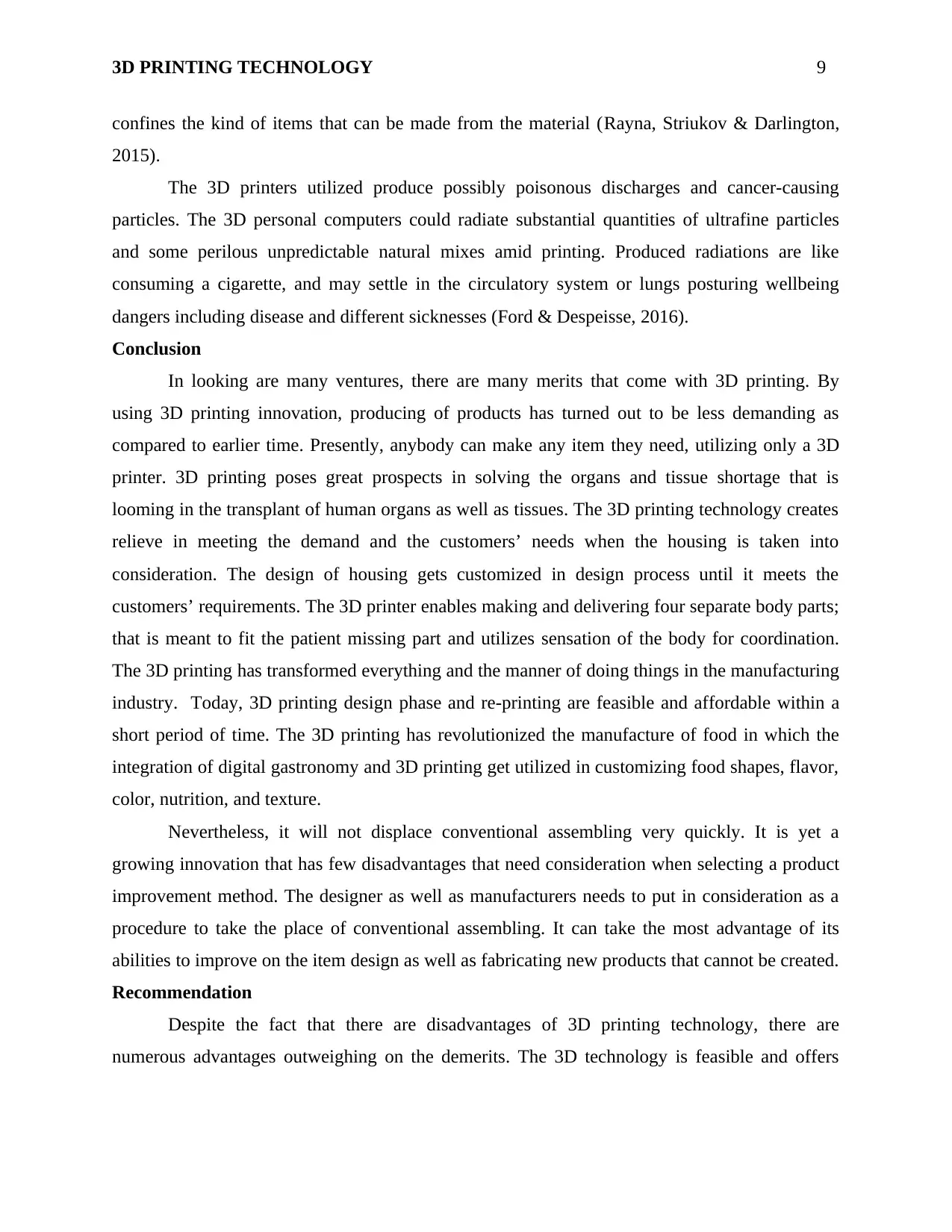
3D PRINTING TECHNOLOGY 9
confines the kind of items that can be made from the material (Rayna, Striukov & Darlington,
2015).
The 3D printers utilized produce possibly poisonous discharges and cancer-causing
particles. The 3D personal computers could radiate substantial quantities of ultrafine particles
and some perilous unpredictable natural mixes amid printing. Produced radiations are like
consuming a cigarette, and may settle in the circulatory system or lungs posturing wellbeing
dangers including disease and different sicknesses (Ford & Despeisse, 2016).
Conclusion
In looking are many ventures, there are many merits that come with 3D printing. By
using 3D printing innovation, producing of products has turned out to be less demanding as
compared to earlier time. Presently, anybody can make any item they need, utilizing only a 3D
printer. 3D printing poses great prospects in solving the organs and tissue shortage that is
looming in the transplant of human organs as well as tissues. The 3D printing technology creates
relieve in meeting the demand and the customers’ needs when the housing is taken into
consideration. The design of housing gets customized in design process until it meets the
customers’ requirements. The 3D printer enables making and delivering four separate body parts;
that is meant to fit the patient missing part and utilizes sensation of the body for coordination.
The 3D printing has transformed everything and the manner of doing things in the manufacturing
industry. Today, 3D printing design phase and re-printing are feasible and affordable within a
short period of time. The 3D printing has revolutionized the manufacture of food in which the
integration of digital gastronomy and 3D printing get utilized in customizing food shapes, flavor,
color, nutrition, and texture.
Nevertheless, it will not displace conventional assembling very quickly. It is yet a
growing innovation that has few disadvantages that need consideration when selecting a product
improvement method. The designer as well as manufacturers needs to put in consideration as a
procedure to take the place of conventional assembling. It can take the most advantage of its
abilities to improve on the item design as well as fabricating new products that cannot be created.
Recommendation
Despite the fact that there are disadvantages of 3D printing technology, there are
numerous advantages outweighing on the demerits. The 3D technology is feasible and offers
confines the kind of items that can be made from the material (Rayna, Striukov & Darlington,
2015).
The 3D printers utilized produce possibly poisonous discharges and cancer-causing
particles. The 3D personal computers could radiate substantial quantities of ultrafine particles
and some perilous unpredictable natural mixes amid printing. Produced radiations are like
consuming a cigarette, and may settle in the circulatory system or lungs posturing wellbeing
dangers including disease and different sicknesses (Ford & Despeisse, 2016).
Conclusion
In looking are many ventures, there are many merits that come with 3D printing. By
using 3D printing innovation, producing of products has turned out to be less demanding as
compared to earlier time. Presently, anybody can make any item they need, utilizing only a 3D
printer. 3D printing poses great prospects in solving the organs and tissue shortage that is
looming in the transplant of human organs as well as tissues. The 3D printing technology creates
relieve in meeting the demand and the customers’ needs when the housing is taken into
consideration. The design of housing gets customized in design process until it meets the
customers’ requirements. The 3D printer enables making and delivering four separate body parts;
that is meant to fit the patient missing part and utilizes sensation of the body for coordination.
The 3D printing has transformed everything and the manner of doing things in the manufacturing
industry. Today, 3D printing design phase and re-printing are feasible and affordable within a
short period of time. The 3D printing has revolutionized the manufacture of food in which the
integration of digital gastronomy and 3D printing get utilized in customizing food shapes, flavor,
color, nutrition, and texture.
Nevertheless, it will not displace conventional assembling very quickly. It is yet a
growing innovation that has few disadvantages that need consideration when selecting a product
improvement method. The designer as well as manufacturers needs to put in consideration as a
procedure to take the place of conventional assembling. It can take the most advantage of its
abilities to improve on the item design as well as fabricating new products that cannot be created.
Recommendation
Despite the fact that there are disadvantages of 3D printing technology, there are
numerous advantages outweighing on the demerits. The 3D technology is feasible and offers
⊘ This is a preview!⊘
Do you want full access?
Subscribe today to unlock all pages.

Trusted by 1+ million students worldwide

3D PRINTING TECHNOLOGY 10
prospects for the organization. As a result, there is the need for the organization to specialize in
three areas of 3D technology in curving a niche in the technology market.
The first one is specializing in 3D printing technology for the development of human
tissue and organs as well as the Bionic section of the creation of body parts. The reason is that
there are shortages in the donation of body parts and this technology will get embraced by many
people within the region and globally.
Secondly, venturing into 3D technology for prototyping, innovation, and housing as this
reduces the cost of production and manufacturing. Alongside this, specializing in 3D printing
technology that facilitates the creation of cheap and affordable houses to meet high housing
demand.
The third is specialization in 3D printers for the creation of nutritious food which will be
advantageous to the rural people without balanced healthy meals. This presents a huge market
for the product. The use of 3D printing technology is faster, easy and produces a whole meal
within a short time.
prospects for the organization. As a result, there is the need for the organization to specialize in
three areas of 3D technology in curving a niche in the technology market.
The first one is specializing in 3D printing technology for the development of human
tissue and organs as well as the Bionic section of the creation of body parts. The reason is that
there are shortages in the donation of body parts and this technology will get embraced by many
people within the region and globally.
Secondly, venturing into 3D technology for prototyping, innovation, and housing as this
reduces the cost of production and manufacturing. Alongside this, specializing in 3D printing
technology that facilitates the creation of cheap and affordable houses to meet high housing
demand.
The third is specialization in 3D printers for the creation of nutritious food which will be
advantageous to the rural people without balanced healthy meals. This presents a huge market
for the product. The use of 3D printing technology is faster, easy and produces a whole meal
within a short time.
Paraphrase This Document
Need a fresh take? Get an instant paraphrase of this document with our AI Paraphraser
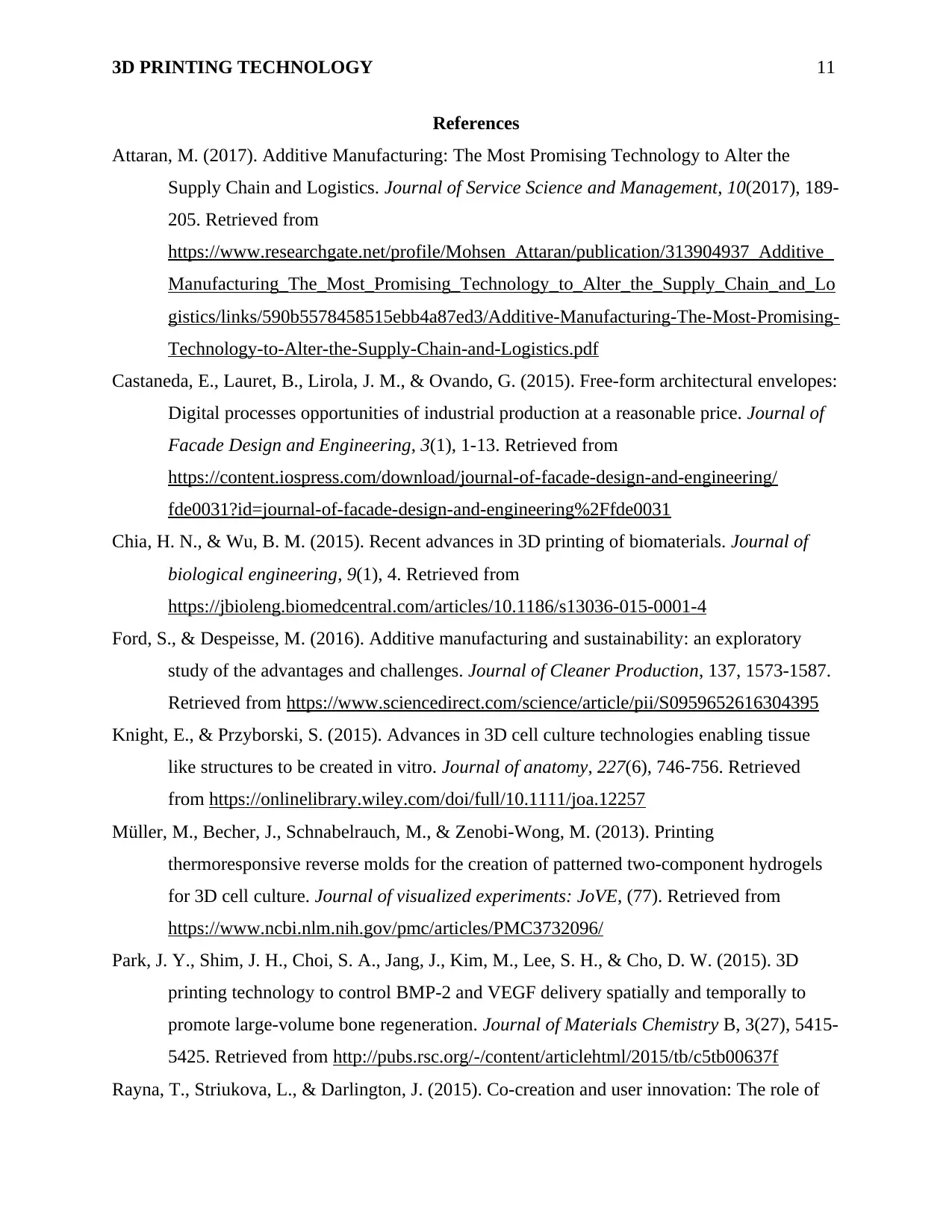
3D PRINTING TECHNOLOGY 11
References
Attaran, M. (2017). Additive Manufacturing: The Most Promising Technology to Alter the
Supply Chain and Logistics. Journal of Service Science and Management, 10(2017), 189-
205. Retrieved from
https://www.researchgate.net/profile/Mohsen_Attaran/publication/313904937_Additive_
Manufacturing_The_Most_Promising_Technology_to_Alter_the_Supply_Chain_and_Lo
gistics/links/590b5578458515ebb4a87ed3/Additive-Manufacturing-The-Most-Promising-
Technology-to-Alter-the-Supply-Chain-and-Logistics.pdf
Castaneda, E., Lauret, B., Lirola, J. M., & Ovando, G. (2015). Free-form architectural envelopes:
Digital processes opportunities of industrial production at a reasonable price. Journal of
Facade Design and Engineering, 3(1), 1-13. Retrieved from
https://content.iospress.com/download/journal-of-facade-design-and-engineering/
fde0031?id=journal-of-facade-design-and-engineering%2Ffde0031
Chia, H. N., & Wu, B. M. (2015). Recent advances in 3D printing of biomaterials. Journal of
biological engineering, 9(1), 4. Retrieved from
https://jbioleng.biomedcentral.com/articles/10.1186/s13036-015-0001-4
Ford, S., & Despeisse, M. (2016). Additive manufacturing and sustainability: an exploratory
study of the advantages and challenges. Journal of Cleaner Production, 137, 1573-1587.
Retrieved from https://www.sciencedirect.com/science/article/pii/S0959652616304395
Knight, E., & Przyborski, S. (2015). Advances in 3D cell culture technologies enabling tissue
like structures to be created in vitro. Journal of anatomy, 227(6), 746-756. Retrieved
from https://onlinelibrary.wiley.com/doi/full/10.1111/joa.12257
Müller, M., Becher, J., Schnabelrauch, M., & Zenobi-Wong, M. (2013). Printing
thermoresponsive reverse molds for the creation of patterned two-component hydrogels
for 3D cell culture. Journal of visualized experiments: JoVE, (77). Retrieved from
https://www.ncbi.nlm.nih.gov/pmc/articles/PMC3732096/
Park, J. Y., Shim, J. H., Choi, S. A., Jang, J., Kim, M., Lee, S. H., & Cho, D. W. (2015). 3D
printing technology to control BMP-2 and VEGF delivery spatially and temporally to
promote large-volume bone regeneration. Journal of Materials Chemistry B, 3(27), 5415-
5425. Retrieved from http://pubs.rsc.org/-/content/articlehtml/2015/tb/c5tb00637f
Rayna, T., Striukova, L., & Darlington, J. (2015). Co-creation and user innovation: The role of
References
Attaran, M. (2017). Additive Manufacturing: The Most Promising Technology to Alter the
Supply Chain and Logistics. Journal of Service Science and Management, 10(2017), 189-
205. Retrieved from
https://www.researchgate.net/profile/Mohsen_Attaran/publication/313904937_Additive_
Manufacturing_The_Most_Promising_Technology_to_Alter_the_Supply_Chain_and_Lo
gistics/links/590b5578458515ebb4a87ed3/Additive-Manufacturing-The-Most-Promising-
Technology-to-Alter-the-Supply-Chain-and-Logistics.pdf
Castaneda, E., Lauret, B., Lirola, J. M., & Ovando, G. (2015). Free-form architectural envelopes:
Digital processes opportunities of industrial production at a reasonable price. Journal of
Facade Design and Engineering, 3(1), 1-13. Retrieved from
https://content.iospress.com/download/journal-of-facade-design-and-engineering/
fde0031?id=journal-of-facade-design-and-engineering%2Ffde0031
Chia, H. N., & Wu, B. M. (2015). Recent advances in 3D printing of biomaterials. Journal of
biological engineering, 9(1), 4. Retrieved from
https://jbioleng.biomedcentral.com/articles/10.1186/s13036-015-0001-4
Ford, S., & Despeisse, M. (2016). Additive manufacturing and sustainability: an exploratory
study of the advantages and challenges. Journal of Cleaner Production, 137, 1573-1587.
Retrieved from https://www.sciencedirect.com/science/article/pii/S0959652616304395
Knight, E., & Przyborski, S. (2015). Advances in 3D cell culture technologies enabling tissue
like structures to be created in vitro. Journal of anatomy, 227(6), 746-756. Retrieved
from https://onlinelibrary.wiley.com/doi/full/10.1111/joa.12257
Müller, M., Becher, J., Schnabelrauch, M., & Zenobi-Wong, M. (2013). Printing
thermoresponsive reverse molds for the creation of patterned two-component hydrogels
for 3D cell culture. Journal of visualized experiments: JoVE, (77). Retrieved from
https://www.ncbi.nlm.nih.gov/pmc/articles/PMC3732096/
Park, J. Y., Shim, J. H., Choi, S. A., Jang, J., Kim, M., Lee, S. H., & Cho, D. W. (2015). 3D
printing technology to control BMP-2 and VEGF delivery spatially and temporally to
promote large-volume bone regeneration. Journal of Materials Chemistry B, 3(27), 5415-
5425. Retrieved from http://pubs.rsc.org/-/content/articlehtml/2015/tb/c5tb00637f
Rayna, T., Striukova, L., & Darlington, J. (2015). Co-creation and user innovation: The role of
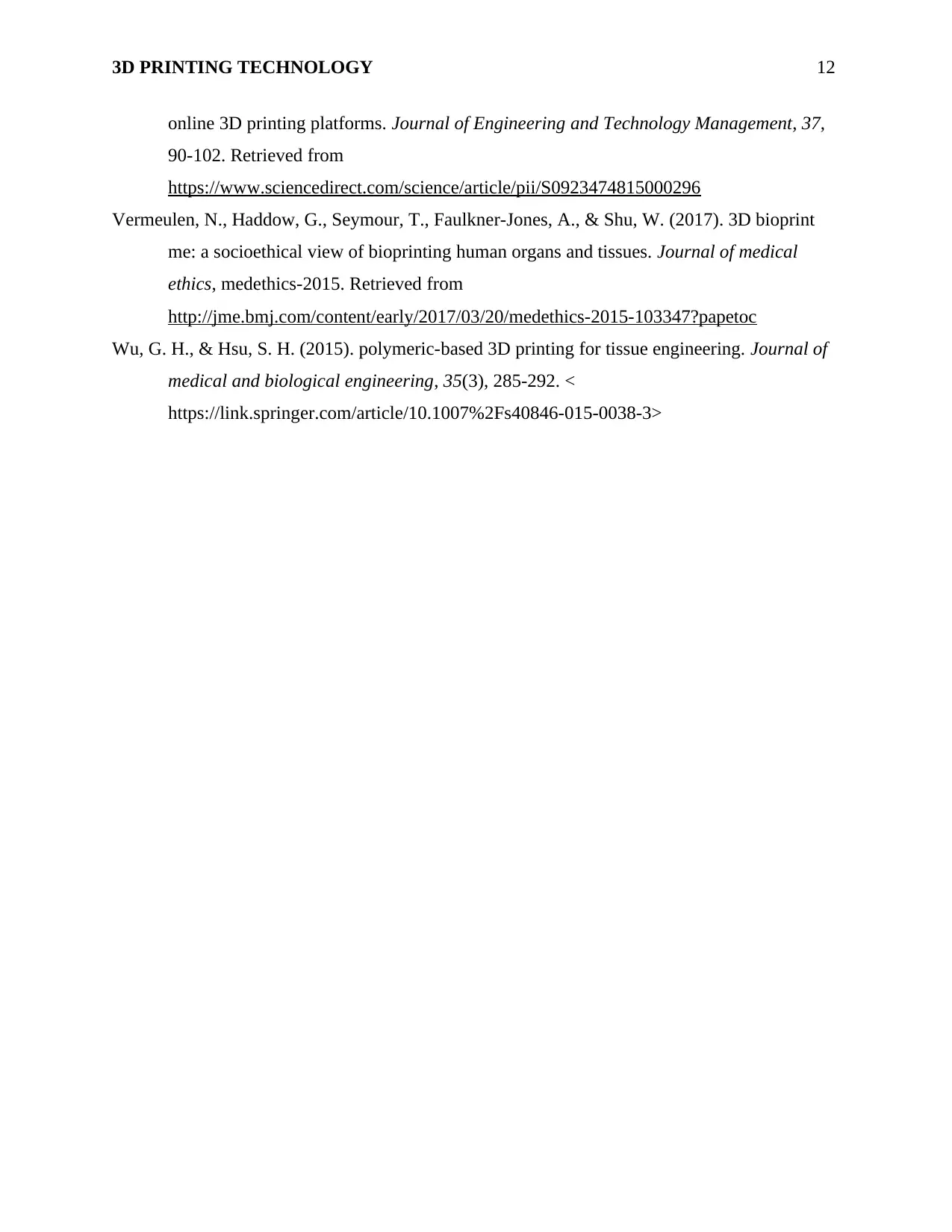
3D PRINTING TECHNOLOGY 12
online 3D printing platforms. Journal of Engineering and Technology Management, 37,
90-102. Retrieved from
https://www.sciencedirect.com/science/article/pii/S0923474815000296
Vermeulen, N., Haddow, G., Seymour, T., Faulkner-Jones, A., & Shu, W. (2017). 3D bioprint
me: a socioethical view of bioprinting human organs and tissues. Journal of medical
ethics, medethics-2015. Retrieved from
http://jme.bmj.com/content/early/2017/03/20/medethics-2015-103347?papetoc
Wu, G. H., & Hsu, S. H. (2015). polymeric-based 3D printing for tissue engineering. Journal of
medical and biological engineering, 35(3), 285-292. <
https://link.springer.com/article/10.1007%2Fs40846-015-0038-3>
online 3D printing platforms. Journal of Engineering and Technology Management, 37,
90-102. Retrieved from
https://www.sciencedirect.com/science/article/pii/S0923474815000296
Vermeulen, N., Haddow, G., Seymour, T., Faulkner-Jones, A., & Shu, W. (2017). 3D bioprint
me: a socioethical view of bioprinting human organs and tissues. Journal of medical
ethics, medethics-2015. Retrieved from
http://jme.bmj.com/content/early/2017/03/20/medethics-2015-103347?papetoc
Wu, G. H., & Hsu, S. H. (2015). polymeric-based 3D printing for tissue engineering. Journal of
medical and biological engineering, 35(3), 285-292. <
https://link.springer.com/article/10.1007%2Fs40846-015-0038-3>
⊘ This is a preview!⊘
Do you want full access?
Subscribe today to unlock all pages.

Trusted by 1+ million students worldwide
1 out of 12
Related Documents
Your All-in-One AI-Powered Toolkit for Academic Success.
+13062052269
info@desklib.com
Available 24*7 on WhatsApp / Email
![[object Object]](/_next/static/media/star-bottom.7253800d.svg)
Unlock your academic potential
Copyright © 2020–2025 A2Z Services. All Rights Reserved. Developed and managed by ZUCOL.





